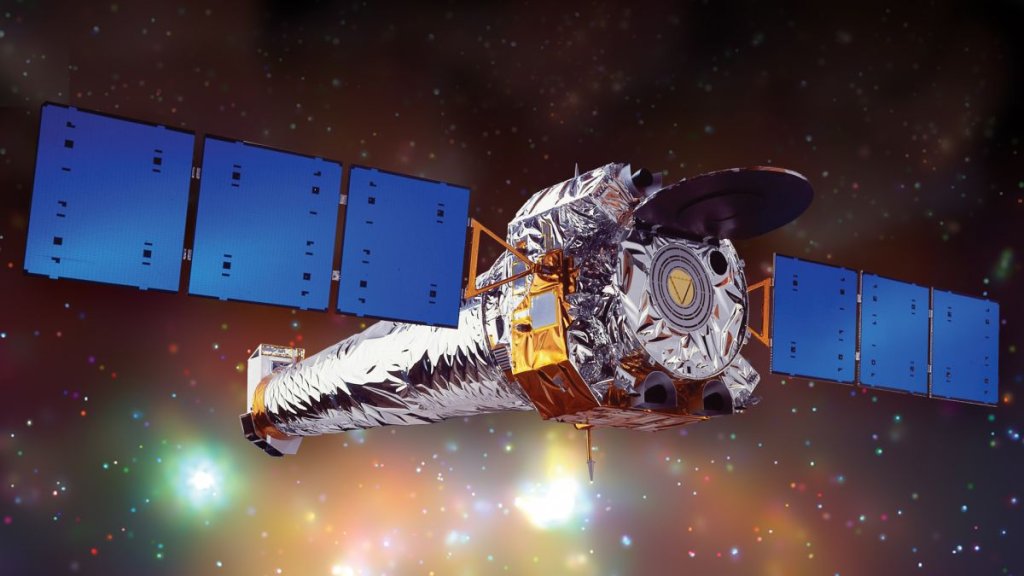
Private servicing mission could extend life of NASA’s Chandra space telescope (Image Credit: Space.com)
Nearly a quarter-century after its launch, a famed NASA X-ray telescope may get its first service call in space.
The Chandra X-Ray Observatory launched to Earth orbit in July 1999 to study high-energy events in the universe. Despite a few glitches in recent years, the telescope remains in good health — and a proposed private servicing mission could keep it that way.
For the past 18 months, Northrop Grumman has been quietly exploring a mission concept to Chandra, whose orbit reaches to more than one-third the distance of the moon. And this isn’t the only ambitious possible space telescope servicing mission in the works; private companies are also investigating the possibility of sending spacecraft out to NASA’s Hubble Space Telescope and Spitzer Space Telescope.
Each mission presents its own challenges. Hubble is close to Earth, but the space shuttle originally designed to service it has retired. Spitzer is incredibly far from our planet, at two astronomical units (sun-Earth distances), but there is no active risk to observations given that the scope was shut off in 2020. Chandra, by comparison, is both far from Earth (in a highly elliptical orbit) and also still in service, creating an interesting servicing puzzle.
Related: New private plan to rescue Hubble Space Telescope may also target space junk
The possible Chandra servicing mission was first brought forward publicly at the American Astronomical Society’s annual Goddard Space Symposium in March 2022, via remarks from Jared Rieckewald. He was then senior director of business development at Northrop Grumman’s subsidiary, SpaceLogistics. (Rieckewald died unexpectedly in February 2023 (opens in new tab) at age 44.)
The proposal would send a space tug (known as a mission extension vehicle) to Chandra that would be “purpose-built” for the telescope, Rieckewald said; at the time, he suggested SpaceLogistics could send the unsolicited proposal to NASA as soon as the end of 2022. Northrop Grumman has not commented publicly on the matter since being quoted in an IEEE Spectrum report (opens in new tab) in October 2022, however.
“It could extend Chandra by decades,” Rieckewald noted in recorded remarks (opens in new tab) about the proposal. The mission would not only allow Chandra to continue scrutinizing the universe in X-ray wavelengths, which are impossible to see on Earth’s surface due to our atmosphere, but also to work with the recently launched James Webb Space Telescope. Chandra has already reexamined Webb images to gain new insights in X-ray wavelengths.
Related: Iconic James Webb Space Telescope images get X-ray vision boost
The most recent U.S. decadal survey in astrophysics, released in 2021, included mention of a new X-ray telescope — but at a lesser priority than a space observatory optimized to study infrared, optical and ultraviolet wavelengths. (The decadal survey is a community consensus of scientific priorities.)
“We think we have options that help NASA sustain (Chandra) at a fraction of the price of a new observatory,” Rieckewald said of the survey. Looking at Hubble’s service history, he added, the team suggests that top issues to think about while servicing Chandra would be refueling and maintaining scientific precision of its instruments.
Making sure Chandra’s instruments are tuned properly is an especially crucial matter in X-ray observations, given that the observatory records extremely short wavelengths of 0.01 to 10 nanometers. (A nanometer is equal to one-billionth of a meter.) That leaves less of a margin of error to work with than visual light, which has much longer wavelengths of roughly 380 to 700 nanometers, according to NASA (opens in new tab).
Follow us on Twitter @Spacedotcom (opens in new tab) or Facebook (opens in new tab).





